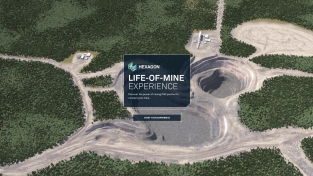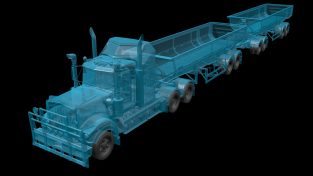Safety, sustainability and efficiency can suffer at any mine where the data from planning, operations, safety and business analytics are siloed. Integration between IDS GeoRadar and Hexagon’s MineProtect portfolio now means that these important data sources can be shared in one platform.
NJ: Integration between IDS GeoRadar and Hexagon’s Mine Protect Portfolio now connects systems for safety and radar-based slope stability hazards. Via real-time equipment visualisation, integration ensures timely alerts about hazardous areas for people and machinery. This additional layer of information means better risk evaluation. It’s also one more way to ensure everyone gets home safely.
Thanks for tuning in. Hi, I’m Neville Judd from Hexagon Radio. Safety, sustainability and efficiency can suffer at any mine where the data from planning, operations, safety and business analytics are siloed. Integration between IDS GeoRadar and Hexagon’s MineProtect Portfolio now means that these important data sources can be shared in one platform. With us to discuss the implications are Hexagon’s MineProtect Portfolio Manager Marcos Bayuelo and Francesco Copi, Director of Monitoring Radar Product Management with IDS GeoRadar. Gentlemen thanks for joining us today.
FC: Thanks, Nev, for this opportunity to talk about this integration.
MB: Thanks very much, Nev, for having us.
NJ: You’re welcome, guys. Glad you could be with us today. Francesco, let’s start with you. We know mines can be dangerous places with busy traffic, blind spots, noise, distraction and poor visibility. How does rock behaviour and slope stability affect this scenario and who are the people most at risk?
FC: Slope failure and rock falls are among the main causes of casualties in mines. So, for that reason mining companies invest a lot of money every year in monitoring equipment to keep that risk under control. Trying to avoid any kind of incident for workers and at the same time assuring the continuity of the production. For sure, among all the people working on any pit mine the most at risk are the workers that spend the most time in the pit, such as haul truck drivers, shovel operator, drilling machine operators and aet cetera. And as you said, they already have to be focused on their job with no possibility to notice ground instability or relative risk. In particular, the most dangerous areas in the pit are where the extraction is in progress due to the instability induced by blasting activities and the material removal which can continuously affects the ground stability.
NJ: Thank you Francesco. Marcos, Hexagon already has systems for collision avoidance, personal protection and tracking radar. Why did it make sense to integrate with IDS GeoRadar?
MB: I think this is a good question and the use case became quite obvious, but this is really enhancing and enabling the opportunity to close the loop between our rock monitoring and our on-vehicle or onboard devices. So, this really allows us to close the loop of overall value proposition from total monitoring for prevention and reaction but as well take this and provide real time notifications to all our vehicles and people on the field. So, this is important to annotate because now every vehicle with a collision avoidance device or every person with a personal alert tag would be able to really take actions from alerts or dangers detected from our Insar radars, which really it is enabling the near real time decision making that our vehicle drivers and our people on the field needs to take to prevent an accident of course, right? But as well it enables the understanding from a remote perspective without having to be on the field to understand who is in the danger zone for the management of our assets and our people. So really this allows us to remotely monitor the controls of our safety and rock stability programmes which saves time in communication, it improves the safety and at the end is helping us to prevent accidents and saving lives.
NJ: Francesco, tell us about IDS GeoRadar and IDS Guardian in particular.
FC: We approached the mining market about 10 years ago, 2010, and we started from a few radar units per year and now we a present in more than 150 mine sites, spread all over the world, with almost 400 radars that are 24/7 monitoring the slope deformation and providing automatic alert in case of instability. In the IDS GeoRadar offering, Guardian is the software platform collecting the data from multiple radars that are operating in one pit. Showing in real time the deformation measured by the radars overlaid on the 3D model of the pit. In this way it’s easy to identify the location of potential instability by looking at the 3D model of the pit and putting in practise the full pit monitoring concept. Which is one of the main strengths of Guardian. The fact that in a single user interface you can have the full control of ground displacement all over the pit and to get a new measurement every couple of minutes. So, you can keep under control the ongoing slope deformation with the possibility to set up automatic alerts and to be warned in case of deformation acceleration that could be a precursor of potential slope failure. Such alerts are automatically notified to the Geo tech by means of email, text message or visual feedback. So, what happened today before this integration is that the Geo tech would go to Guardian, look at the deformation, look at what’s happening, what’s going on and decide if it is necessary to close or not the access to a specific area and communicates this manually by calling some people. Instead with this integration with Guardian and the MineProtect Collision Avoidance System this communication will be almost automatic and timely. You save a lot of time to communicate the area to be evacuated to the mine workers. In practise, the Geo tech engineer will be able to just push a button in Guardian to communicate the area to be evacuated through the Collision Avoidance System server, which in a few minutes will notify such information to the entire open pit fleet and the haul truck driver will see the alerts while driving saving a lot of time in this communication.
NJ: So, Marcos, Francesco has alluded to that essence of time and how important it is to save time in these kind of situations but who benefits most from this integration and why?
MB: So, of course who gets the main benefits out of this integration initially are the vehicle drivers. So, the vehicle drivers immediately know which zone they should not go because it’s closed. So, they are immediately being preventive. They understand and in real time understand where not to go. But as well the second really beneficial point of view is the mine management. So, as the mine management we created a certain amount of processes and controls that we put in place to keep accidents from happening and this is what Francesco mentioned. So now we have an alert, the Geo tech needs to call the supervisor, the supervisor needs to go to the specific field and close the road. So, this process might take from a half an hour to a couple of hours, right? So then, how do you make sure that within this time there is no accident or that you have evacuated everybody. Now this becomes instantaneous. Everybody in the mine knows without any single human intervention beyond the click from the Geo tech, to really know where not to go or if they are already in the danger zone they can evacuate automatically. So, this is the main direct benefits or the people who really benefit now, but if you look from the broader perspective, now we are benefiting all of our customers because if you have one or other solutions now you can close the loop within Hexagon technology solutions. And looking even broader, any mine site that is really looking forward to minimising their risk of not only collision avoidance and wall instability but how do you really minimise the overall risk of accidents using these solutions. So, we are enabling or providing benefits to all the layers of user personas or possible future customers.
NJ: Right. Francesco, from a productivity perspective why would it make sense for a mine to invest in this kind of integrated solution?
FC: The answer is pretty simple, and it is to improve further the safety standards. This is achieved by reducing the time between the identification of the risk related to ground instability detected by radar and implementation of the actions needed to mitigate the risk itself, which in the most extreme case could mean to save lives. As we know mine productivity and safety are strictly related to each other. If you think that closing an operation because of an incident can cost millions per day. Therefore, higher safety level means higher productivity and I think this is the reason why a mine should invest in this integration.
NJ: So, I’m interested in getting both of your responses to this next question and Francesco maybe you can answer first. What distinguishes Hexagon’s work in this area of mine safety from any other vendor in the market?
FC: I would say the comprehensiveness of each solution. No other company in the market like Hexagon can provide under its umbrella a set of solutions covering any aspect of the life of a mine. In particular, in this case both the monitoring of the ground stability and the safety of the fleet operation. And exactly the availability of such a system triggered and made possible the integration between Guardian and the Collision Avoidance system, which I think represents a real innovation in the market and it is just a starting point, as there can be much more integration between these two worlds to bring more and more benefits to the mine environment.
NJ: And Marcos.
MB: I think this integration brings a very, very huge or a major solution differentiator and it is not only because of the fact that within Hexagon we provide the best in the market technology for rock instability and monitoring and collision avoidance and now we’re putting this together. But just the fact that within Hexagon we empower the inter-operability of our solutions to really create added value for our customers. So, we just don’t only sell them individual solutions, we enable our solutions to work within workflows to really add value, extra to our customers from our solutions. So, it’s basically one plus one is now giving them three and in the future as Francesco is saying, we can really start expanding these use cases as they start coming.
NJ: And again, final question if I can get both your thoughts on this and maybe Marcos you can go first, where do you see future development in mine safety solutions?
MB: I think in the future, as I said is, we are just giving one step within the integration on workflows development within our companies and this will be increased with the use case that we will start finding once we start delivering one after the other but I as well I see a huge future development in transforming the safety data in performance indicators and how this is going to be used to enhance decision making to really have an impact on measuring and improving the safety. Beyond what we feel today is that is a lot of gut feeling. And this is the first of our safety integrations within Hexagon but soon we will start expanding our integration not only to do safety but safety productivities to have a real measure on how safety impacts productivity as Francesco mentioned and what is our real impact on making that decision. So, we really have to measure and once we start measuring this will enable us to really go deeper on improving productivity and safety.
NJ: Francesco.
FC: In a few words and in a wide sense I see the future in the combination of data to provide added value information. To make more informed decisions and a faster reaction to risk. I would try to explain myself better. Today already in a mine there are tons of data acquired by different platforms and for different needs which if combined together could add much more. As Marcos said one plus one could be three not two and not just talking about data aggregation or visualisation but combined as a process. By for instance, exploiting artificial intelligence to predict in advance a potential situational risk and for a better management of those risks. I see this trend already in place in the slope deformation monitoring field where the deformation data acquired with different technology are used to predict potential future slope instability. And I think that there is even much more potential by combining monitoring data with mine operation data for instance and the integration we are talking about today is not artificial intelligence but goes exactly into this direction of combination of data.
NJ: Gentlemen sounds like exciting times ahead. Thanks so much for joining us today. A big thank you to our guests Marcos and Francesco. For more information about today’s topic visit hexagonmining.com and idsgeoradar.com. To listen to additional episodes or learn more visit hxgnspotlight.com. Thanks for tuning in.
















